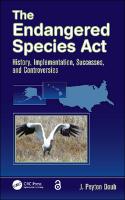The Endangered Species Act
Proposal review
History, Implementation, Successes, and Controversies
| dc.contributor.author | Doub, J. Peyton | |
| dc.date.accessioned | 2020-08-13T11:53:06Z | |
| dc.date.available | 2020-08-13T11:53:06Z | |
| dc.date.issued | 2012 | |
| dc.identifier | ONIX_20200813_9781466507371_10 | |
| dc.identifier | OCN: 811563629 | |
| dc.identifier.uri | https://library.oapen.org/handle/20.500.12657/41268 | |
| dc.description.abstract | The complex regulations of the Endangered Species Act established by the U.S. Fish and Wildlife Service can be challenging for environmental professionals who must comply with them or assist clients in compliance. This is true especially for those without a background in biology or ecology. The Endangered Species Act: History, Implementation, Successes, and Controversies discusses the Act using clear scientific prose that all professionals whose activities fit into the ESA compliance process can readily comprehend, including those with limited education in science. The book begins by exploring the deeply rooted history of the Endangered Species Act, which extends back decades preceding its enactment in 1973. It continues with a discussion of the basic scientific theory underlying the Act and provides an overview of its key regulations. The author also examines the Act in the context of other key environmental planning statutes such as the National Environmental Policy Act and the Clean Water Act, especially Section 404 of the Clean Water Act, which relates specifically to wetlands. The remainder of the book details the regulatory processes faced by other government agencies and private developers who must routinely ensure that their actions comply with the Endangered Species Act. It concludes with a broad discussion of current controversies associated with the Act and how those controversies might ultimately change how environmental practitioners will have to comply with the Act in the future. The book is neither a defense of the Endangered Species Act and its associated regulations nor a call to repeal or modify the Act or regulations. The presentation is factual and avoids the hype and hyperbole commonly directed at the Act by both environmental activists and deregulation proponents. Readers will gain a solid understanding of how the Act was established, what goals were envisioned by its framers, how current environmental practice under the Act has been shaped, and how those practices might be changed in the future. | |
| dc.language | English | |
| dc.subject.classification | thema EDItEUR::L Law::LN Laws of specific jurisdictions and specific areas of law::LNK Environment, transport and planning law: general::LNKJ Environment law | en_US |
| dc.subject.classification | thema EDItEUR::R Earth Sciences, Geography, Environment, Planning::RN The environment::RNC Applied ecology | en_US |
| dc.subject.classification | thema EDItEUR::P Mathematics and Science::PS Biology, life sciences | en_US |
| dc.subject.classification | thema EDItEUR::P Mathematics and Science::PS Biology, life sciences::PSV Zoology and animal sciences | en_US |
| dc.subject.other | Environment law | |
| dc.subject.other | Applied ecology | |
| dc.subject.other | Biology | |
| dc.subject.other | life sciences | |
| dc.subject.other | Zoology & animal sciences | |
| dc.title | The Endangered Species Act | |
| dc.title.alternative | History, Implementation, Successes, and Controversies | |
| dc.type | book | |
| oapen.identifier.doi | 10.1201/b12933 | |
| oapen.relation.isPublishedBy | 7b3c7b10-5b1e-40b3-860e-c6dd5197f0bb | |
| oapen.imprint | CRC Press | |
| oapen.place.publication | Boca Raton | |
| peerreview.anonymity | Single-anonymised | |
| peerreview.id | bc80075c-96cc-4740-a9f3-a234bc2598f1 | |
| peerreview.open.review | No | |
| peerreview.publish.responsibility | Publisher | |
| peerreview.review.stage | Pre-publication | |
| peerreview.review.type | Proposal | |
| peerreview.reviewer.type | Internal editor | |
| peerreview.reviewer.type | External peer reviewer | |
| peerreview.title | Proposal review | |
| oapen.review.comments | Taylor & Francis open access titles are reviewed as a minimum at proposal stage by at least two external peer reviewers and an internal editor (additional reviews may be sought and additional content reviewed as required). |

